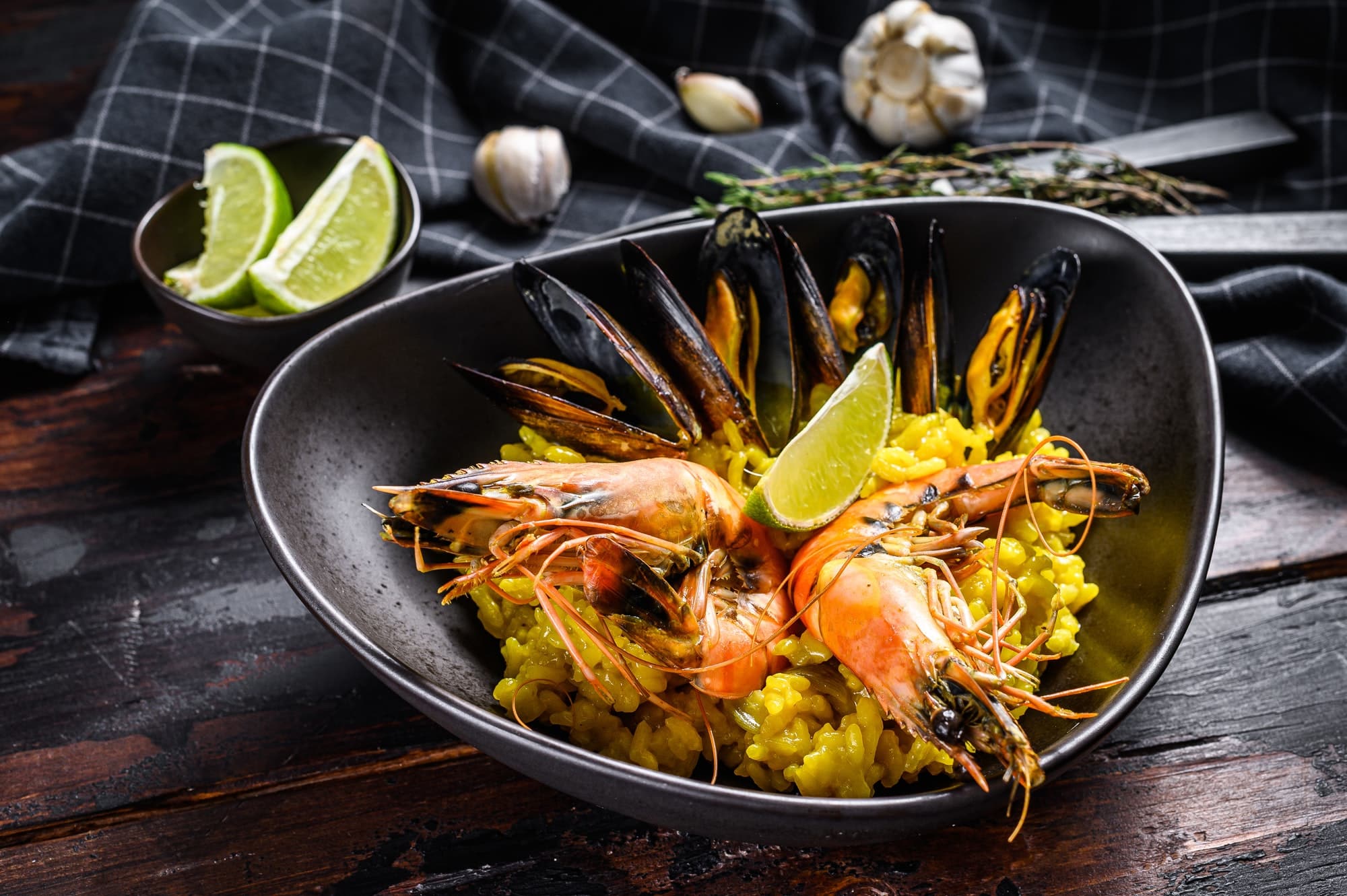What are the secrets to a perfect seafood paella with a crispy socarrat?

Whenever the term "paella" is mentioned, it stirs up a mental image full of vibrant colors, delightful smells, and a taste that is simply divine. Originating from the Spanish region of Valencia, paella is an iconic dish that has crossed borders and won the hearts of gourmets worldwide. But what is the secret to cooking a perfect seafood paella, one that even features a crispy socarrat? This article will unravel the mystery behind the revered dish and offer tips to take your cooking skills up a notch.
Choosing the Right Ingredients
First off, a perfect paella starts with selecting the best ingredients. This traditional Spanish dish gets its hearty flavors and textures from its ingredients, which should be fresh and of high quality.
Also read : Discover the rich flavors of authentic french cheese
When it comes to the rice, use a short-grain variety. The ideal types are Bomba or Calasparra, both native to Spain. These absorb the broth well, contributing to the dish’s rich flavor while maintaining their shape.
The heart of any seafood paella is the seafood itself. Make sure it is fresh and includes a variety of shellfish like prawns, mussels, clams, and squid. This assortment will add a delightful flavor and texture to your dish.
Topic to read : What’s the key to a gourmet chicken piccata with a zesty lemon-caper sauce?
The golden yellow color of paella comes from saffron, a spice derived from the flower of Crocus sativus. It has a unique aroma and taste which cannot be replicated using food colorings or turmeric.
Lastly, the broth, it is vital to the cooking process. You can use either fish or vegetable broth for a seafood paella.
Using the Right Cookware
The cooking process begins with the right cookware. A traditional Spanish paella pan is wide, shallow, and has splayed sides. The design allows for heat to be distributed evenly across the pan, a key factor for cooking the rice uniformly and achieving the much-desired crispy socarrat at the bottom.
This pan is usually made of carbon steel which heats up quickly and retains heat well. The handles on either side make it easy to move. If not available, you can still cook paella in a large, high-quality non-stick frying pan.
Preparing and Cooking the Paella
To start off, heat up the paella pan, add olive oil and cook the chicken until browned. Chicken is optional since it’s a seafood paella, but it can add a more robust flavor. Then, add the seafood, starting with the ones that take longer to cook like squid. After a few minutes, add the remaining seafood.
When the seafood is slightly undercooked, remove it from the pan and set it aside. You will add it back later so it doesn’t overcook and become tough.
In the same pan, sauté the vegetables until they are slightly tender. Then, add the rice, stirring it well to coat each grain with oil, which helps boost its flavor. Next, return the par-cooked seafood to the pan and add in the saffron-infused broth.
From this point on, resist the urge to stir. Let the rice absorb the broth slowly as it cooks. This is the secret to achieving the prized socarrat – the deliciously crispy layer of rice at the bottom of the pan.
Achieving the Perfect Socarrat
The socarrat is the crowning jewel of every authentic Spanish paella. It’s the crispy, caramelized layer of rice at the bottom of the pan that forms during the cooking process. Achieving it requires patience and careful monitoring of the heat.
Once the broth is almost fully absorbed, increase the heat for about a minute or two to encourage the formation of the socarrat. Be careful not to overdo this as the rice can easily burn.
Afterwards, reduce the heat to low and let the paella cook for a few more minutes. This will ensure that the rice is fully cooked and the socarrat is formed, but not burnt.
The Final Touches
When the rice is cooked and the socarrat has been achieved, remove the pan from heat and cover it with a cloth. Let it rest for a few minutes to allow the flavors to meld together.
For a visual treat, arrange lemon wedges and fresh parsley attractively on top of the cooked paella. The lemon adds a refreshing zing that complements the hearty flavors of the seafood and rice, while the parsley adds a touch of freshness.
And voila! You’ve just made a perfect seafood paella complete with a crispy socarrat! It’s a recipe that takes time and patience, but the end result is more than worth it. So, next time you decide to make a paella, remember these secrets and you’re sure to impress your guests.
The Charm of Authentic Spanish Ingredients
An authentic paella hinges on the authenticity of its ingredients. Spain, being rich in culinary heritage, has a bounty of native ingredients that give paella its unique taste and texture. Apart from the saffron, Bomba rice is an integral part of the dish. This short-grain rice, native to Spain, possesses a unique ability to absorb large amounts of broth, swelling in size, while still retaining its firmness.
Many chefs also recommend using Spanish olive oil. This oil’s high smoke point makes it ideal for the high heat required in the paella cooking process. Moreover, Spanish olive oil has a vibrant taste that adds another layer of flavor to the paella.
The seafood used in the paella also plays a crucial role in the dish’s authenticity. Spanish coastal areas are known for their abundant seafood, including shrimp, mussels, clams, and squid. Each of these adds a unique taste and texture to the paella, creating a symphony of flavors in every bite.
Lastly, the traditional paella Valenciana also includes green beans and chicken, along with the seafood. These ingredients provide a unique contrast of flavors and textures, enhancing the overall experience of eating the paella.
The Art of Cooking Paella
Cooking paella is as much an art as it is a science. It all begins with heating your paella pan over high heat. Once hot, you add your Spanish olive oil, followed by the chicken (if you are using it), and let it brown nicely. This initial searing process ensures that your chicken, if used, and seafood, get a beautiful, caramelized exterior, which adds a depth of flavor to your paella.
Next, you add the seafood, starting with those that take the longest to cook. As each piece of seafood is perfectly cooked, remove it from the pan and set it aside. This step is crucial, as it prevents the seafood from overcooking and becoming tough.
In the same frying pan, you then sauté your vegetables until they are just tender. This is followed by the addition of the Bomba rice. The rice should be stirred well, ensuring each grain is coated in the flavorful oil.
At this stage, you return the partially cooked seafood to the pan and add your saffron-infused broth. From here on, the paella rice is left to cook undisturbed, allowing it to absorb the broth and form the coveted socarrat at the bottom of the pan.
Conclusion
Cooking an authentic seafood paella with a crispy socarrat might seem daunting, but with the right ingredients and technique, it can be an enjoyable culinary experience. Remember, the key factors are using a traditional paella pan, high-quality Spanish ingredients like Bomba rice and saffron, and patiently allowing the rice to cook without stirring.
Whether it’s the vibrant colors, the tantalizing aromas, or the delightful mix of flavors, a well-cooked paella promises a gastronomical adventure. So, the next time you’re in the mood for Spanish food, why not try your hand at this iconic dish? With this comprehensive guide, you’re sure to impress your guests with a perfect seafood paella, complete with an irresistibly crispy socarrat. Enjoy the journey and, most importantly, the delicious destination that is a well-cooked paella!
